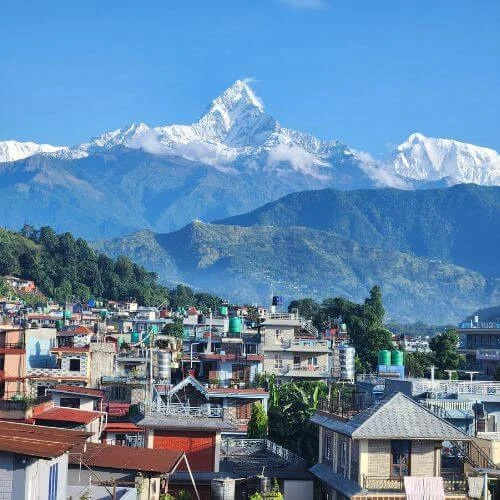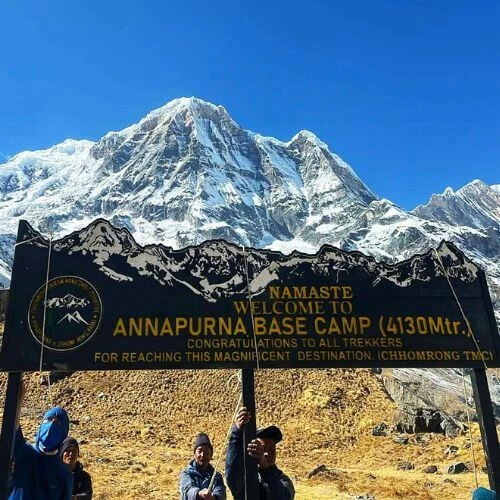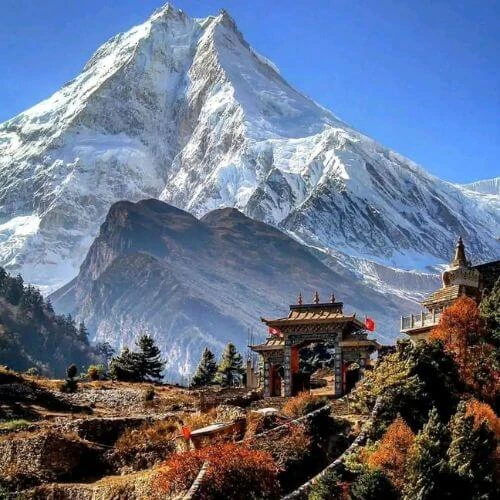Basic Itinerary of Rara Lake Trek
Day 1: Fly from Kathmandu to Nepaljung
Day 2: Fly from Nepalgunj to Jumla
Day 3: Trek to Chere Chaur
Day 4: Trek to Khali Langa
Day 5: Trek to Rara Lake
Day 6: Explore Rara Lake
Day 7: Trek back to Khali Laga
Day 8: Trek to Chere Chaur
Day 9: Trek to Jumla
Day 10: Fly to Nepaljung
Day 11: Fly back to Kathmandu
How to reach Rara Lake?
By air
The most convenient and shortest means of transportation to Rara Lake is by air transport. One can even board a flight from Kathmandu to Nepalgunj and transfer to another airport from Nepalgunj to Talcha Airport. From Talcha is about 3-4 hours of trekking to Rara Lake. However, one can fly to Jumla but from Jumla one has to trek for couple of days to get to the lake.
By road
Traveling to Rara Lake via roadways can be exhausting, as it involves day-long drives. First of all, one has to travel a distance of about 500 km from Kathmandu to Kohalpur. Furthermore, 250 km of drive to Kalikot and then to Salleri in Mugu are required. From Salleri, one needs to hike in order to reach Rara Lake. Once one has explored the lake, the return would be via driving back through Nepalgunj and eventually to Kathmandu
By Hike/ Trek
If you are out to Rara Lake Trek there are various trail that one can decide to undertake. The most frequented choice is to take a flight to Jumla and then hike to Rara Lake which will take around 3-4 days. The trail passes through Jumla, Chere, Burma, Chauta Bazaar and ends at Rara Lake. On your return, you can trek to Talcha Airport from which you can fly back to Nepalgunj and then to Kathmandu.
Best time to Visit Rara Lake
Visiting Rara Lake is possible year-round, and each season offers a unique perspective of the lake. The best time to visit Rara Lake is from September to November and April to May. During these months, the weather is mild, clear skies, and pleasant temperatures; hence, perfect for trekking and enjoying the beauty of the lake. It is in September that the monsoon gets over and the dry trails with lush landscapes remain behind. During the spring, the surrounding forests comes alive with blooming rhododendrons. The winters are pretty cold, lots of snow blocks its access, and the monsoon season trek makes the trails slippery and not at all easy to walk.

Activities to do around Rara Lake
Trekking and Hiking
Rara National Park is a fantastic destination for trekking and hiking, offering diverse experiences for nature lovers. As you explore the hiking trails in Rara, you’ll walk through beautiful forests, up and down hills, and follow scenic paths that take you deep into the wilderness. One of the highlights is trekking to Rara Lake, the largest lake in Nepal, surrounded by snow-capped mountains and lush green forests, providing breathtaking views at every turn.
The highest point of the trek is Murma Dada, which offers an incredible panoramic view of the lake and the surrounding landscape. Reaching this viewpoint is a rewarding experience that makes the journey even more special.
Trekking here also offers the exciting opportunity to spot wildlife. You may encounter animals like musk deer, Himalayan black bears, and a variety of colorful birds as you quietly make your way through the park. The trails cater to all experience levels, from beginners to seasoned hikers. Some are easy and flat, while others are more challenging, ensuring there’s something for everyone.
Many treks include the option to camp overnight. You can set up tents, gather around a campfire, and wake up to the beauty of the mountain sunrise. Along the way, you’ll pass through small villages, allowing you to meet local people and experience their traditional mountain lifestyle, adding cultural richness to your adventure.
Boating and Fishing
Boating on Rara Lake is a relaxing and enjoyable way to experience the lake's beauty from a new angle. You can glide across the clear waters in a small rowboat or canoe. The calm lake makes for a smooth and peaceful ride. From the middle of the lake, you get stunning views of the surrounding mountains and forests, offering a perspective you can’t get from land.

If you wish to, you can also take a swim in the cool, refreshing water. On warm days, the lake’s cold water is especially refreshing.
Rara Lake is also a great spot for fishing, with snow trout and other fish in its waters. You can try your hand at fishing using simple rods or local traditional methods. The park authorities will guide you on the proper fishing techniques to ensure it’s done in an eco-friendly way.
The lake is perfect for photography, too. Whether it’s capturing the mountain reflections in the water or a glowing sunset, there are plenty of beautiful shots to take from your boat. The cool air around the lake makes the experience even more refreshing on a warm day.
Camping
Camping in Rara National Park is a wonderful way to immerse yourself in nature. You can set up a tent that acts as your cozy home in the great outdoors. The park has designated camping areas, usually flat spots that offer beautiful views of the landscape. If allowed, you can gather around a small campfire to keep warm and cook your meals.
At night, the absence of city lights creates a stunning opportunity for stargazing, with the sky filled with countless stars. This peaceful atmosphere is perfect for relaxation. In the morning, you'll wake up to the cheerful sounds of birds singing and the sight of misty mountains, deepening your connection to nature.

While you may not find regular bathrooms or showers, this adds to the authentic outdoor experience. During your stay, you can meet other campers and share stories around the campfire. Remember to follow the "Leave No Trace" principles by cleaning up after yourself and respecting the environment.
Wildlife viewing
Wildlife viewing in Rara National Park offers a fantastic chance to see various animals and birds in their natural habitats. The best times to spot wildlife are early mornings and evenings when animals are most active. To increase the chances of seeing them, it's essential to stay quiet and be patient, as loud noises can scare them away. Using binoculars can enhance the experience, allowing for a closer look at birds.

Joining guided tours with park rangers is a great option, as they know the best spots for animal sightings and can help identify different species. While exploring, visitors can learn to recognize signs of wildlife, such as footprints and droppings, indicating that animals have recently been nearby. In the park, one might encounter musk deer, Himalayan black bears, leopards, and a variety of birds. It is important to note that different animals may appear in various seasons, with migratory birds visiting at specific times of the year.
Historical Significance of Rara Lake
Rara Lake has a very significant position in Nepalese history, specifically because of its relation to King Mahendra, the King of Nepal from 1955 to 1972. King Mahendra visited Rara in 1964 during one of his campaigns in the most isolated areas of Nepal. Enchanted by the beauty of this peaceful lake, he even wrote a poem named Rara Ki Apsara ("The Nymph of Rara"), drawing the attention of the entire nation toward the lake. His visit and the poetic tribute played a key role in bringing Rara Lake into recognition as one of the natural wonders of Nepal.
King Mahendra's visit motivated the initiation of conservation in the area. His fascination with Rara inspired interest in the preservation of the pristine environment of the area, which led to the establishment of Rara National Park in 1976. A national park was created around the lake, dedicated to the protection of the ecosystems of the lake and the surrounding forests.

The surroundings of Rara Lake were inhabited by several small farming communities, primarily of Malla and Khas ethnic group origins, even before the declaration as a national park. Locals had been living in harmony with nature from centuries, dependent upon agriculture, livestock, and the lake as sources of their livelihood. When the government declared that area of the country as a national park, the local residents were relocated to save the natural landscape. This was an important step for conservation but created long-lasting social and cultural impacts on communities displaced by the event.
In 2007, Rara Lake was further recognized for its ecological value as a Ramsar site. The Ramsar Convention is an international treaty relating to the conservation and to sustainable usage of wetlands. This designation brought world attention to Rara's unique wetland ecosystem, which serves as a critical habitat for migratory birds, fish, and endangered species such as the snow trout and the red panda. The recognition from Ramsar also called for striking a balance between tourism with sustainable environmental practices, thus making Rara Lake more identified as a natural treasure of Nepal.
Difficulty Level of Rara Lake Trek
The trek to Rara Lake is graded as moderately difficult, hence it is equally suitable for trekkers and adventurers. The trail contains hills with steep paths that pass through forests and mountain landscapes. The ground may be rugged and rocky, and you will need to watch your step, but varied terrains keep the journey engaging.
Rara Lake's altitude is about 2,990 meters above sea level. While the height does bring minor discomfort in breathing for those unaccustomed to such high altitudes, proper acclimatization manages this quite well.
Generally, it takes 3 to 5 days, but this depends on your walking speed and choice of route. While moderately long, a reasonable level of fitness and stamina is useful. For anyone who either walks or hikes regularly, the trek will feel far more comfortable.

Basic teahouses and lodges are available along the way, but they offer very few facilities compared with other more popular routes to trek. Trekkers should be prepared for simple accommodation and less in terms of amenities.
In fact anyone with good preparation and a positive attitude, most people in reasonable health can enjoy the trek to Rara Lake.
Accommodation in Rara Lake
Since Rara Lake is pretty far from modernization, there are hardly any different unique accommodations that could be located within it. For such a beautiful place, one should prepare their mind to stay in places that are very basic and rustic. The most popular ways to stay around Rara Lake are camps. There are a number of areas where travelers can pitch their tents, and a some tour operators offer the equipment for camping on behalf of the trip for those visitors who are looking for a guided tour.
There are a few basic guesthouses or lodges available in the nearby village of Rara. These guesthouses or lodges provide basic rooms, usually with shared facilities; hence, one should not expect so much in terms of luxury. Other outstanding places providing accommodations include the Nepal Army Eco Lodge. It is said to offer basic rooms with limited amenities, providing slight better comfort for visitors. Another option is Danfe Lodge, which reportedly offers relatively better comfort compared to other local lodges.

For those seeking a more cultural experience, homestays in the surrounding villages may be arranged. Some local families open their homes to visitors, giving them an opportunity to immerse themselves in the local way of life. Whatever type of accommodation, facilities are very basic. Electricity can be limited and hot water is not always available.
Since Rara Lake is situated in a very remote area, reservations of your accommodation through a tour operator are always highly advisable in advance
Food and water facilities in Rara Lake
Food and water facilities at Rara Lake are basic due to its remote location. You’ll find simple Nepali meals, with dal bhat (lentils and rice) being the main dish. Vegetarian meals are common, though chicken or mutton might occasionally be available. Teahouses and lodges around the lake offer these basic meals, and there’s also an army-run canteen serving simple food.
If you plan to hike or explore for the day, some accommodations can prepare packed lunches. However, the availability of fresh produce depends on the season, so food options might be limited. It’s a good idea to inform your hosts in advance if you have dietary restrictions, as options may be scarce. Packing some snacks or supplementary food items is also helpful.

Safe drinking water is limited at Rara Lake. The lake and nearby streams are the main water sources, but you must treat the water before drinking. Make sure to bring water purification tablets, a portable filter, or a UV purifier.
Conclusion
Rara Lake is still fairly isolated in Nepal, where visitors can find a natural environment free of large crowds and noisy tourists. Unspoiled by mass tourism, this place is ideal for travelers who want to explore the wild and beautiful landscapes and embrace the natural world. Getting to and even finding affordable lodging at Rara might not be easy and might be quite rustic, but it really pays off. For those tourists ready to travel somewhere far from mainstream locations, this Rara Lake travel guide can be incredibly helpful in navigating the journey. Rara Lake offers stunning beauties of nature at every turn. As the number of tourists increases, so should responsibility when visiting, ensuring the preservation of this spectacular area for future generations.

Frequently asked questions
1. Can you swim in Rara Lake?
Swimming is not allowed in Rara Lake to protect its ecosystem and keep the water clean.
2. What animals can you see around Rara Lake?
You can spot animals like red pandas, Himalayan black bears, musk deer, and various birds, including migratory species, around Rara Lake.
3. How long does it take to trek to Rara Lake?
Depending on your route and pace, it usually takes 4 to 5 days of trekking along scenic paths through villages and forests.

4. Is Rara Lake suitable for camping?
Yes, camping in Rara Lake is possible in its defined camping sites.
5. What is the temperature at Rara Lake?
The temperature of Rara Lake is about 20°C during summer but below freezing in winter, especially at night.
6. What is the nearest town to Rara Lake?
Gamgadhi is the nearest town to Rara Lake. You can get there by walking for 2 to 3 hours.
7. Are there boat rides available on Rara Lake?
Yes, you can go on a boating ride in Rara Lake to see the beautiful surroundings from the water.
8. Where is Rara Lake located?
Rara Lake is located in the Mugu District of northwestern Nepal, within Rara National Park.















